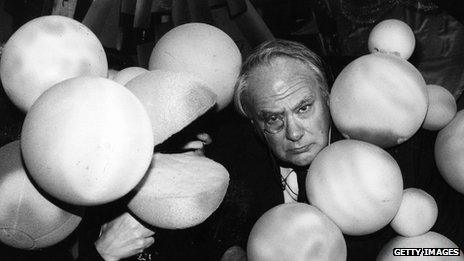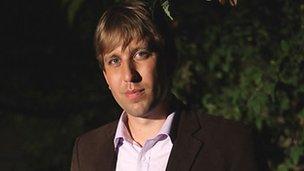Sir Patrick Moore: Chris Lintott's tribute
- Published

Sir Patrick's first broadcast was in 1957
Sir Patrick Moore made a huge mark on astronomy, made all the remarkable by his insistence that he was not and never had been a professional scientist.
He counted himself as a writer and broadcaster first and foremost, but as Britain's most recognisable scientist for more than 50 years, he inspired countless people to take up astronomy as a hobby or astrophysics as a career.
His own education was unconventional. He was prevented from attending Eton by illness. He then found himself thrown into the melee of World War II, lying about his age and signing up for the Royal Air Force at the age of 15.
Following the war, he turned down a place at the University of Cambridge in favour of working, first, briefly, as a teacher and then as a freelance writer.
'Treasured by scientists'
Yet the year 1957 saw two launches that would dramatically change Sir Patrick's life.
The first was of Sputnik 1, the first artificial satellite which fired the starting gun on the space race.
The second, six months earlier, was of the Sky at Night. Initially commissioned for a trial period of three episodes, the programme and its presenter ran without a break for more than 50 years.
The Sky at Night is treasured by scientists not only because of its longevity, but because it allowed them to talk about what they're most passionate about - their work.
One of Sir Patrick's favourite anecdotes was about his interview in 1970 with Neil Armstrong.
Sinking into the chair opposite Sir Patrick after a gruelling set of interviews which focused on politics and funding, the beleaguered astronaut lit up: "Now we can talk about science," he said.
This science-led focus was entirely due to Sir Patrick's strong lead, but the reason it worked was because of his ability to represent the viewer.
Where others would have lost their audience when talking about the difficult stuff - the Sky at Night even attempted a programme dedicated to general relativity in 1969 - Sir Patrick was trusted and could be relied upon to interject when necessary.
'Open house'

Dr Chris Lintott worked with Sir Patrick on the BBC One programme The Sky at Night
This ability to speak plainly and clearly to his audience was also evident in his writing.
He published well over 100 books, ranging from works of serious scholarship - he was particularly proud of his survey of pre-space age observations of Neptune - to books for kids of all ages.
These books in particular inspired a generation of schoolchildren to take up astronomy and it was a regular occurrence for Sir Patrick to be presented with dog-eared copies of long forgotten titles by eminent professors looking for his signature.
Many of them will have been among the legions of fans whose letters bombarded Sir Patrick, each of which would get a reply bashed out on Sir Patrick's long-suffering Woodstock typewriter.
This personal encouragement from a national figure must have motivated countless enthusiasts to pursue a scientific career.
It did not stop at letters either. Sir Patrick took every opportunity to meet his audience, undertaking lectures, tours, public appearances and more.
Farthings, Sir Patrick's home in Selsey in West Sussex, ran for years as an effective open house and science centre, with the observatory in the garden.
This was primarily used for Sir Patrick's own observations of the Moon and planets, but was also open to passing amateur astronomers, youth groups and anyone else who might be inspired by a glimpse of the sky.
In short, Sir Patrick dedicated his life to talking about astronomy at any opportunity - not out of a desire to make a name for himself or to further an agenda, but because he thought the world would be a better place if he did so.
For more than half a century, it was.
- Published9 December 2012
- Published9 December 2012
- Published9 December 2012
- Published9 December 2012
- Published9 December 2012
- Published28 February 2011